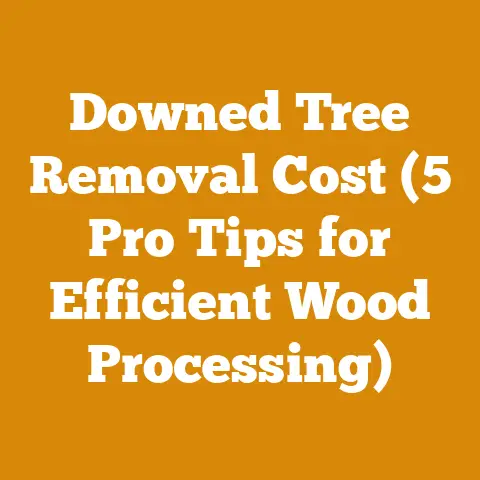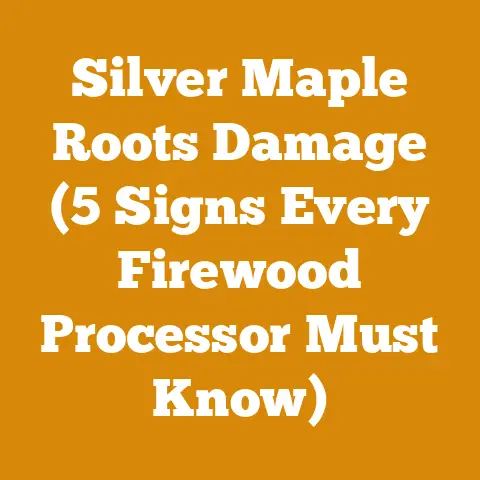Average Cost for Tree Stump Grinding (5 Pro Tips for Precision)
Average Cost for Tree Stump Grinding: 5 Pro Tips for Precision
Investing in tree stump grinding might not be the first thing that comes to mind when you think about home improvement, but trust me, it’s an investment that pays off in spades. Whether you’re looking to reclaim your yard, prevent unwanted tree regrowth, or simply improve the aesthetics of your property, grinding those unsightly stumps is the way to go. As someone who’s spent years knee-deep in sawdust and the satisfying roar of chainsaws, I’ve learned a thing or two about the costs involved and how to get the most bang for your buck. So, let’s dive into the nitty-gritty of tree stump grinding costs and I’ll share 5 pro tips for getting it done right, and keeping your budget in check.
Understanding the Investment: Why Grind Stumps?
Before we get into the numbers, let’s quickly touch on why you should even bother with stump grinding. Leaving a stump in your yard is like leaving an open invitation for pests, diseases, and unwanted sprouts. Plus, it’s a tripping hazard and an eyesore. Grinding the stump down eliminates these problems and opens up possibilities for replanting, landscaping, or even building. It’s about reclaiming your space and adding value to your property.
Breaking Down the Cost Factors
The cost of stump grinding isn’t a one-size-fits-all affair. Several factors come into play, influencing the final price you’ll pay. Understanding these factors is crucial for getting an accurate estimate and avoiding surprises down the road.
- Stump Size: This is the biggest cost driver. Larger stumps require more time, effort, and equipment, which translates to a higher price tag. The diameter of the stump, measured at ground level, is the key measurement here.
- Stump Quantity: If you have multiple stumps to grind, you might be able to negotiate a better rate. Many companies offer discounts for bulk jobs.
- Stump Accessibility: A stump located in a wide-open space is much easier to grind than one tucked away in a tight corner or surrounded by obstacles. Accessibility directly impacts the time and effort required.
- Stump Age and Species: Older, well-established stumps can be tougher to grind due to denser wood and extensive root systems. The species of tree also matters. Some woods are naturally harder and more resistant to grinding. I’ve personally found oak and maple stumps to be particularly challenging.
- Location: Prices can vary significantly depending on your geographic location. Areas with higher labor costs and stricter regulations will generally have higher stump grinding rates.
- Root System: The extent of the root system underground also plays a role. A stump with sprawling roots will require more grinding to ensure complete removal.
- Travel Costs: Some companies charge a travel fee, especially if you’re located outside their primary service area. Be sure to factor this into your overall cost estimate.
- Permits: Depending on your local regulations, you might need a permit to grind a tree stump, especially if it’s located near public utilities or in a protected area. The cost of permits can vary widely.
- Cleanup: The cost often includes the removal of stump grindings. However, some companies charge extra for this service. It’s important to clarify whether cleanup is included in the initial estimate.
The Average Cost: Data-Driven Insights
So, what’s the bottom line? What can you expect to pay for tree stump grinding? Based on my research and experience, here’s a breakdown of the average costs:
- Per-Stump Pricing: The most common pricing method is based on the size of the stump. Expect to pay anywhere from $2 to $5 per inch of diameter. For example, a 20-inch stump could cost between $40 and $100 to grind.
- Hourly Rates: Some companies charge an hourly rate, typically ranging from $150 to $250 per hour. This method is often used for larger or more complex jobs.
- Minimum Service Fee: Many companies have a minimum service fee, usually around $100 to $150. This covers their travel and setup costs.
Statistical Data and Benchmarks:
According to a recent survey conducted by HomeAdvisor, the national average cost for tree stump grinding ranges from $75 to $400 per stump. However, this is just an average. Prices can vary significantly based on the factors mentioned above.
- Regional Differences: I have seen significant regional differences. For example, in urban areas of the Northeast, where labor costs are high, stump grinding can easily cost 20-30% more than in rural areas of the Midwest.
- Equipment Rental: If you’re feeling ambitious, you can rent a stump grinder yourself. Rental rates typically range from $75 to $200 per day, depending on the size and type of machine. However, keep in mind that operating a stump grinder can be dangerous, and it’s not a task for the faint of heart.
Case Study: My Own Stump Grinding Experience
I once had to grind a massive oak stump in my own backyard. It was about 36 inches in diameter and located in a relatively accessible area. I got quotes from three different companies, ranging from $150 to $350. I ended up going with the company that offered the best combination of price and experience. The job took about 3 hours, and the results were fantastic. It completely transformed my backyard and allowed me to finally build the garden I had always dreamed of.
5 Pro Tips for Precision and Cost Optimization
Now that you have a better understanding of the costs involved, let’s move on to some pro tips for getting the job done right and keeping your budget in check.
1. Get Multiple Quotes: This is the golden rule of any home improvement project. Don’t settle for the first quote you receive. Get at least three different estimates from reputable companies. Compare their prices, services, and customer reviews.
- Negotiation Tactics: Don’t be afraid to negotiate. Once you have multiple quotes, you can use them to leverage a better price. Let each company know that you’re comparing bids and see if they’re willing to offer a discount.
2. Assess Accessibility and Prepare the Site: Before the stump grinding crew arrives, take some time to prepare the site. Clear away any rocks, debris, or obstacles that could hinder their work. This will save them time and potentially lower the overall cost.
- Underground Utilities: It’s crucial to check for underground utilities before grinding a stump. Call your local utility companies to mark the location of any buried lines. Grinding into a gas or electric line can be extremely dangerous and costly.
3. Consider Renting a Stump Grinder (With Caution): If you’re a DIY enthusiast and have some experience with power equipment, you might consider renting a stump grinder. However, be aware that these machines are powerful and can be dangerous if not operated properly.
- Safety First: Always wear safety glasses, ear protection, and heavy gloves when operating a stump grinder. Read the operating manual carefully and follow all safety precautions. Start with a smaller stump to get a feel for the machine before tackling a larger one.
- Cost Analysis: Compare the cost of renting a stump grinder to the cost of hiring a professional. Factor in the rental fee, fuel costs, and your time. If you only have one or two small stumps to grind, renting might be a cost-effective option. However, for larger or more complex jobs, hiring a professional is usually the better choice.
4. Inquire About Cleanup Options: Find out whether the company includes cleanup in their price. Some companies will simply grind the stump and leave the grindings behind. Others will remove the grindings and fill the hole with topsoil.
- Reusing Grindings: Stump grindings can be used as mulch in your garden or composted. If you’re on a tight budget, you can save money by handling the cleanup yourself and reusing the grindings.
- Filling the Hole: Once the stump is ground down, you’ll need to fill the hole with topsoil. This will prevent the ground from settling and create a smooth surface for planting or landscaping.
5. Time Your Project Wisely: The time of year can affect the cost of stump grinding. During the busy season (spring and summer), companies are often booked solid and may charge higher prices. Consider scheduling your project during the off-season (fall or winter) when demand is lower.
- Weather Considerations: Be mindful of the weather. Grinding a stump in wet or muddy conditions can be messy and time-consuming. It’s best to wait for a dry day to get the job done.
- Seasonal Discounts: Some companies offer seasonal discounts during the off-season. Be sure to ask about any special promotions or deals.
Deep Dive into Cost Components
Let’s get even more granular and examine the individual cost components that make up the total price of stump grinding.
- Labor Costs: This is a significant portion of the overall cost. Labor rates vary depending on the company, the location, and the experience of the crew. Skilled operators with years of experience will naturally command higher wages.
- Equipment Costs: Stump grinders are expensive machines, and companies need to factor in the cost of purchasing, maintaining, and operating them. This includes fuel, repairs, and insurance.
- Transportation Costs: The cost of transporting the stump grinder to and from your property can also add to the overall price. This is especially true if you’re located far from the company’s base of operations.
- Disposal Fees: If the company is removing the stump grindings, they may need to pay disposal fees at a local landfill or recycling center. These fees can vary depending on the volume of grindings and the regulations in your area.
- Insurance and Licensing: Reputable stump grinding companies will carry insurance to protect themselves and their customers from liability. They will also be licensed to operate in your area. These costs are factored into their pricing.
- Profit Margin: Of course, companies need to make a profit to stay in business. Their profit margin will vary depending on their overhead costs, competition, and market conditions.
Budgeting and Cost Management: A Detailed Approach
Creating a budget is essential for any home improvement project, and stump grinding is no exception. Here’s a step-by-step approach to budgeting and cost management:
- Assess Your Needs: Determine the number, size, and location of the stumps you need to grind. Take accurate measurements of the diameter of each stump.
- Gather Quotes: Get at least three different quotes from reputable companies. Be sure to provide them with accurate information about the stumps and the accessibility of the site.
- Analyze the Quotes: Carefully review each quote and compare the prices, services, and terms. Pay attention to what’s included in the price and what’s not.
- Create a Spreadsheet: Create a spreadsheet to track your costs. Include columns for the company name, price, services, and any additional fees.
- Set a Budget: Based on your research and analysis, set a realistic budget for your project. Be sure to include a contingency fund for unexpected expenses. I usually recommend adding 10-15% for contingencies.
- Track Your Spending: As the project progresses, track your spending closely. Compare your actual costs to your budgeted costs and make adjustments as needed.
- Look for Savings: Be proactive in looking for ways to save money. Negotiate prices, consider doing some of the work yourself, and take advantage of seasonal discounts.
Calculations and Formulas: Estimating Volume and Costs
Here are some useful calculations and formulas that can help you estimate the volume of stump grindings and the associated costs:
- Volume of a Stump: The volume of a stump can be approximated using the formula for the volume of a cylinder: V = πr²h, where r is the radius of the stump and h is the height. This will give you a rough estimate of the amount of grindings that will be produced.
- Cost per Cubic Foot: Once you have an estimate of the volume of grindings, you can use this information to estimate the cost of disposal. Contact your local landfill or recycling center to find out their disposal fees per cubic foot.
- Fuel Consumption: If you’re renting a stump grinder, you’ll need to factor in the cost of fuel. The fuel consumption rate will vary depending on the size and type of machine. Consult the operating manual for details. These challenges can include:
- Limited Access to Equipment: Stump grinders are expensive machines, and small-scale operators may not have the resources to purchase them. Renting is an option, but it can be costly and inconvenient.
- High Labor Costs: Labor costs can be a significant burden for small-scale operators. They may not be able to afford to hire skilled workers, and they may have to rely on family members or volunteers.
- Strict Regulations: Regulations regarding tree removal and stump grinding can be complex and burdensome. Small-scale operators may not have the time or expertise to navigate these regulations.
- Market Volatility: The market for firewood and wood products can be volatile, and small-scale operators may struggle to compete with larger companies.
- Environmental Concerns: Small-scale operators need to be mindful of environmental concerns when harvesting and processing wood. They need to follow best practices to minimize their impact on the environment.
Actionable Takeaways and Next Steps
Now that you’ve absorbed all this information, here are some actionable takeaways and next steps:
- Assess your needs: Determine the number, size, and location of the stumps you need to grind.
- Get multiple quotes: Contact at least three different companies and get detailed quotes.
- Analyze the quotes: Compare the prices, services, and terms of each quote.
- Set a budget: Create a realistic budget for your project, including a contingency fund.
- Prepare the site: Clear away any obstacles and check for underground utilities.
- Consider renting a stump grinder (with caution): If you’re a DIY enthusiast, renting might be an option.
- Inquire about cleanup options: Find out whether the company includes cleanup in their price.
- Time your project wisely: Consider scheduling your project during the off-season.
- Track your spending: Monitor your costs closely and make adjustments as needed.
- Enjoy your reclaimed space: Once the stump grinding is complete, you can finally enjoy your reclaimed space!
Conclusion: Reclaiming Your Space and Your Budget
Tree stump grinding is an investment that can significantly improve the value and aesthetics of your property. By understanding the cost factors involved and following these pro tips, you can get the job done right, stay within your budget, and reclaim your space. Remember, a little planning and preparation can go a long way in ensuring a successful and cost-effective project. So, go forth, grind those stumps, and create the outdoor space of your dreams! I hope this article helps you in your journey!






